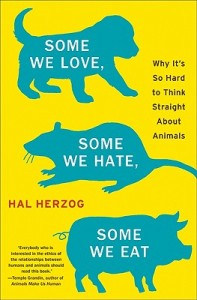I decided to apply to graduate school at the University of Wisconsin-Madison at the recommendation of my undergraduate advisor. I honestly wasn’t thrilled with the idea of coming to the midwest. I had never really considered what the cheese state was like before I applied – as a strictly east coast girl it was so far removed from everything in my life I couldn’t even imagine living here. But, when the college admission chips fell where they did, it was obvious to me that UW Madison was the clear first choice for grad school.
That being said, when I arrived in Wisconsin nearly nine months ago, I knew very little about the history of the University I was attending. I knew that UW-Madison was home to an amazing amount of scientific research, but I had no idea how rich the tradition of scientific inquiry really was. I quickly became aware of the Wisconsin National Primate Research Center (WNPRC) and notorious, and immensely important, psychology researcher Harry Harlow.
Those who follow this blog regularly know that I have written a lot of posts this semester inspired by my zoology class on human and animal behavior. It is this class that really got me motivated to learn more about animal research, and in particular UW-Madison’s role in animal research. That brought me to two books, both written by Deborah Blum a professor in the journalism school here at UW.
 In 1992 Blum won the Pulitzer Prize for a series of articles on the ethical dilemmas posed by primate research. She turned this into the 1994 book The Monkey Wars. I was enthralled by the history of primate research in the United States, and am ashamed to admit how little I knew prior to reading the book. The story of Edward Taub, the Silver Spring Monkeys (named after the site of the lab in Maryland,) and the rise of PETA in 1981 had me riveted. The condensed version of that story is that PETA founder Alex Pacheco volunteered undercover in the lab of Taub, who was conducting neurological experiments on monkeys (severing the nerves to control a limb and then coaxing nerve regeneration.) The monkeys were held in filthy conditions – but there was no legal standard for research animal care at the time. Pacheco took photographs (some admittedly staged) and went to the police to have Taub arrested (which he was – for animal cruelty.)
In 1992 Blum won the Pulitzer Prize for a series of articles on the ethical dilemmas posed by primate research. She turned this into the 1994 book The Monkey Wars. I was enthralled by the history of primate research in the United States, and am ashamed to admit how little I knew prior to reading the book. The story of Edward Taub, the Silver Spring Monkeys (named after the site of the lab in Maryland,) and the rise of PETA in 1981 had me riveted. The condensed version of that story is that PETA founder Alex Pacheco volunteered undercover in the lab of Taub, who was conducting neurological experiments on monkeys (severing the nerves to control a limb and then coaxing nerve regeneration.) The monkeys were held in filthy conditions – but there was no legal standard for research animal care at the time. Pacheco took photographs (some admittedly staged) and went to the police to have Taub arrested (which he was – for animal cruelty.)
The majority of events described in the book take place long before I was even born, and I suppose thats why I felt so removed from them. I didn’t realize I was taking the idea that animals have rights for granted until I learned about the history of animal research in this country. I knew that people are cruel to animals, but I was blissfully oblivious to the cruelty that was standard in research labs in the 1950’s, 1960’s, and 1970’s. After finishing Monkey Wars, my blissful respect for science felt somewhat dingy – and I needed more information.
The book I picked up next, to explore the history of animal research and in particular its role in Wisconsin, was Blum’s 2002 biography of Harry Harlow, Love at Goon Park. I don’t think I had ever heard the name Harry Harlow before moving to Wisconsin – yet his work is something that I reap the benefits of in my daily life. Harlow is both famous and infamous for his “mother love” and “pit of despair” (a catchy term for depression) studies. His research used rhesus macaque babies to show that children need love and social interaction – particularly touch – to function and develop normally, and that being isolated can be the cause of a complete psychological breakdown.
The reason Harlow is so controversial is that the way he studied depression and isolation from one’s mother was to psychologically “break” baby monkeys. These were horrible studies. The monkeys were taken away from their mothers and given a variety of fake substitutes to see which the babies would cling to most (warm, cloth, animated mother was the winning surrogate but cold metal mother caused psychological damage to her babies.) For the depression studies the babies were put in isolation cages for 3-6 months at a time, with no interaction at all. The monkeys suffered tremendously. The concept of love as a necessity needed to be proven, to move parental nurturing into the mainstream. But the question remains if it needed to be proven in that way.
Considering that I was surprised by just how awful the United States history of animal research is, you can imagine how shocking I found it that studies were needed to prove that mothers should hug their children. But then again, as Blum so poignantly points out, the scientific standard at the time was to isolate children for health reasons (limit the spread of bacteria & disease.) What seems so obvious to me – that animals should be well taken care of, that children should be hugged – were really revolutions within the scientific community. Looking back we can say how ridiculous it is that such assertions needed to be scientifically proven, but then again think about where we might be if these ideas had never been generally accepted.
This semester has really driven home for me just how much I owe to animals. The idea that my mom would have been condemned as a bad mother for hugging me when I cried were it not for Harry Harlow and his baby rhesus macaques makes me very appreciative of the role of animals in research. I remember so vividly crying on my Mom’s shoulder at maybe 4 or 5 years old. I remember the silky salmon colored blouse she was wearing. I remember staining it mercilessly with my tears, but I don’t know why I was crying. I do know that all I wanted was to be held, and have my hair stroked and be comforted. I can’t imagine my parents keeping me at arm’s length.
We owe a lot to the animals who started the social movement that changed the way people parented, and the researcher who brought it all to light for making society take notice; and I had no idea about either before coming to Wisconsin. While I do my fair share of whining about being in the cheese state, my experiences here have opened my mind to a lot of new concepts – particularly with regard to the role animals play in society and how we as humans should regard them.
